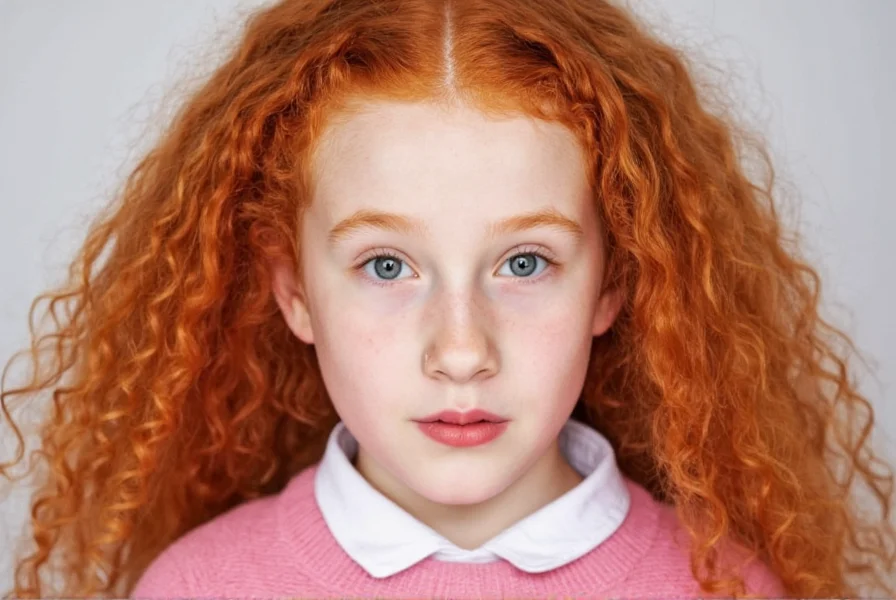Understanding the Genetics Behind Red Hair in Children
Red hair in children stems from recessive variants of the MC1R (Melanocortin-1 Receptor) gene located on chromosome 16. For a child to have red hair, they must inherit two copies of the mutated gene—one from each parent. This explains why red hair often appears unexpectedly in families without recent redheaded ancestors.
Approximately 40% of people carry at least one copy of the red hair variant, making them potential carriers. When both parents carry the variant, their children have a 25% chance of having red hair, a 50% chance of being carriers, and 25% chance of neither having red hair nor carrying the gene.
Physical Characteristics of Ginger Kids
Children with red hair typically display several distinctive physical traits:
| Characteristic | Description | Prevalence in Redheads |
|---|---|---|
| Skin Tone | Fair, often with freckles | 95%+ |
| Eye Color | Blue, green, or hazel | 80% have lighter eyes |
| Hair Texture | Often finer but may be curly | Varies significantly |
| Sun Sensitivity | Burns easily, rarely tans | Nearly 100% |
Health Considerations for Redheaded Children
Ginger kids face several health considerations that parents should understand. Research shows red-haired individuals produce less eumelanin (brown pigment) and more pheomelanin (red pigment), which provides minimal UV protection.
Skin cancer risk is significantly higher among redheads. Studies indicate children with red hair have up to 100 times greater risk of melanoma compared to dark-haired peers when exposed to similar UV levels. Daily sunscreen use with SPF 30+ and protective clothing are essential from infancy.
Emerging research suggests pain perception differences in red-haired individuals. Some studies indicate redheads may require up to 20% more anesthesia during medical procedures and might process pain differently. However, more research is needed specifically on children.
Vitamin D metabolism also differs in ginger kids. Their bodies produce vitamin D more efficiently in low sunlight conditions, which may explain the higher prevalence of red hair in northern European populations. Nevertheless, vitamin D levels should still be monitored, especially in regions with limited sunlight.
Social and Emotional Development
Children with red hair sometimes face unique social challenges. Research published in the Journal of Pediatric Psychology indicates that red-haired children experience slightly higher rates of teasing and bullying compared to their peers.
Parents can support their ginger kids by:
- Building self-esteem through positive reinforcement of their unique appearance
- Teaching appropriate responses to insensitive comments
- Connecting with redhead communities for peer support
- Discussing historical and cultural significance of red hair
Practical Parenting Tips for Families with Redheaded Children
Caring for ginger kids requires some specialized approaches:
Sun Protection Strategies
Implement a comprehensive sun protection plan including:
- SPF 30+ broad-spectrum sunscreen reapplied every two hours
- UPF 50+ clothing for extended outdoor activities
- Sunglasses with UV protection
- Avoiding peak sun hours (10am-4pm) whenever possible
Nutritional Considerations
While no special diet exists for red-haired children, ensuring adequate vitamin D through diet or supplements may be beneficial, particularly in northern climates. Foods rich in antioxidants can also help combat oxidative stress from sun exposure.
Finding Community Support
Connecting with other families of redheaded children provides valuable support. Organizations like the Redhead Club and online communities offer resources, events, and opportunities for ginger kids to meet peers with similar experiences.
Debunking Common Misconceptions About Red Hair
Several myths persist about red-haired individuals that parents should address:
- Myth: Red hair comes from Ireland exclusively
- Fact: While Ireland has the highest concentration (10% of population), red hair occurs worldwide
- Myth: Redheads are going extinct
- Fact: The gene persists in carriers and will continue appearing periodically
- Myth: Red hair always means fair skin
- Fact: Some redheads develop moderate tanning ability
Embracing Red Hair Diversity
Having a ginger child presents a unique opportunity to teach about genetic diversity and celebrate individual differences. Red hair represents one of humanity's most visually distinctive genetic variations, with a rich cultural history across multiple civilizations.
By understanding the specific needs of red-haired children while fostering pride in their unique appearance, parents can help ginger kids develop into confident individuals who appreciate their distinctive heritage. The key lies in balancing necessary health precautions with positive reinforcement of their special characteristics.











 浙公网安备
33010002000092号
浙公网安备
33010002000092号 浙B2-20120091-4
浙B2-20120091-4